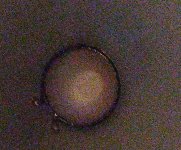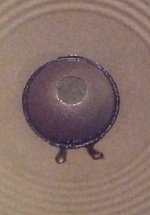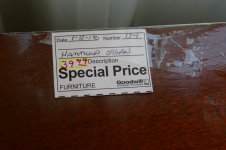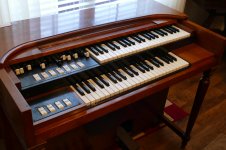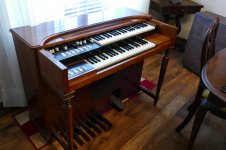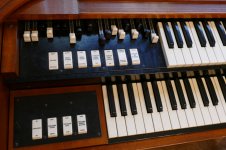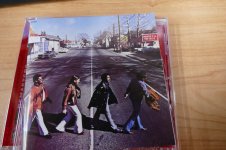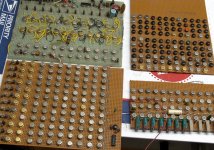Looking for assistance from Hammond L-100 experts. These organs had two dissimilar 12" 16 ohm drivers. The schematic refers to them as "Hi-Res" and "Lo-Res" I have one each of these drivers but I do not know how to tell which is which and what the performance difference in them is.
One has a normal looking dust cap (sealed) and has model and date codes of A024347-0 and 575322 The other has a vented dust cap (a half inch or so hole with a loose weave fabric covering) with codes of A0-24346-0 and 575319
The one with the vented dust cap also has a ribbed cone v.s. a smooth one on the non-vented speaker.
Detail Photos of dust caps...
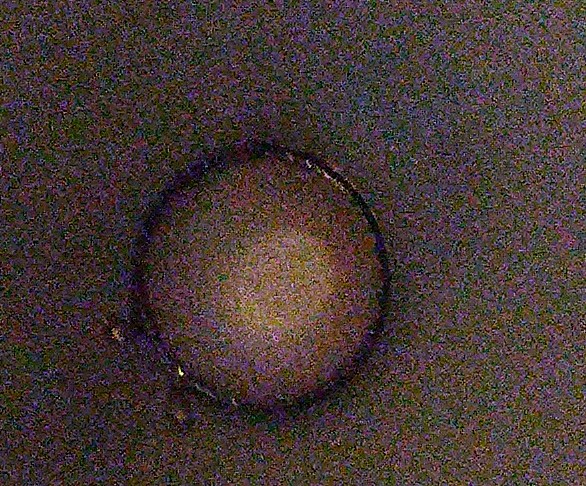
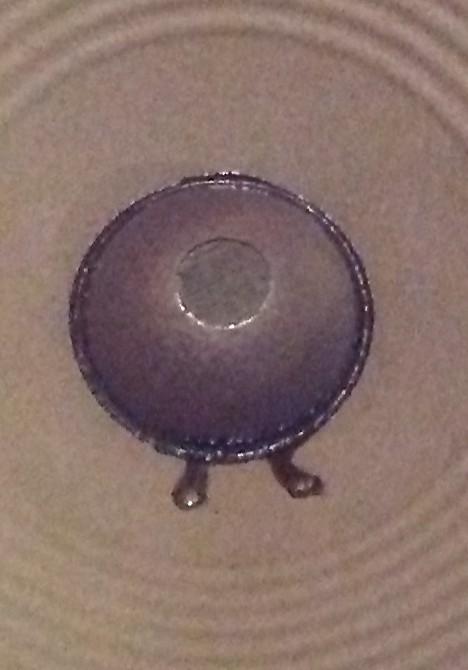
I presume that the designation is intended to indicate high resolution v.s. low resolution but what does that mean in practical terms (or does res mean something else?)? Any idea which one is which?
One has a normal looking dust cap (sealed) and has model and date codes of A024347-0 and 575322 The other has a vented dust cap (a half inch or so hole with a loose weave fabric covering) with codes of A0-24346-0 and 575319
The one with the vented dust cap also has a ribbed cone v.s. a smooth one on the non-vented speaker.
Detail Photos of dust caps...
I presume that the designation is intended to indicate high resolution v.s. low resolution but what does that mean in practical terms (or does res mean something else?)? Any idea which one is which?
Attachments
What you using them for? Hope they are not the pair that I picked up (although them seem similar from recollection). They were crap. Were they out of a Hammond? I can't remember. One was a smooth cone with a semi-parabolic shape, high frequency one, no bass. The other one no highs.
Last edited:
If you're not playing an L-100 I don't see the point in reusing these. Hammond was expert at getting big sound out of 20 watts tubes, from 60 to 4000 hz. They didn't care about weight in the organ market. Watts are cheap now, with ON semi transistors down to $5. When the l-100 was big pnp 10 W TO3 transistors were $10 and a gallon of gas was $.29. Weight matters in the guitar & stage market. These are great for a 150 lb organ, not for much else. They do tend to last forever, as compared with say Allen organ foam surround speakers that come unhinged at 20 years. I'd say PRR's idea about different frequency bnads is important. A frequency sweep test with a calibrated mike is more expensive than his thump test.
An L-100 is just the thing for playing Green Onions. In the great organ scrap out of the last few years, I bought H-100 which had one powerful 15" speaker and two 8" that go to 7000 hz. 70 watts too. Great sounds out of that, and more than one sound than the 0880 of classic rock.
An L-100 is just the thing for playing Green Onions. In the great organ scrap out of the last few years, I bought H-100 which had one powerful 15" speaker and two 8" that go to 7000 hz. 70 watts too. Great sounds out of that, and more than one sound than the 0880 of classic rock.
Last edited:
An L-100 is just the thing for playing Green Onions.
I found what Booker T Jones learned his chops on, an M-3 sitting lonely in the furniture section of a Goodwill store in Pennsylvania.....the asking price, $39.95 sold as furniture only. The plug "was cut off" to prevent electrical use due to it's age and uncertain condition.
Upon getting it home I found that the plug and cord was intact, just stuffed up inside. Inside the bench was the original purchase receipt from 1958, and a receipt for service and lubrication in 2016, just over a year before I bought it. I was thinking that it would need a complete restoration, but I took the chance and plugged it in......It plays perfectly!
Now if only I hadn't tossed my DIY paint can Leslie several years ago.......In reality the paint can speaker sounded OK for a screaming lead guitar, but I don't think it would do well with the left side of the M-3's keyboard....or the pedals. Add one more DIY project to the list.
There have been thoughts of making a MIDI input for this thing using a few hundred reed relays, but I keep pushing that one back into a remote corner of my brain every time it pops up. The major hurdle.....how do you get 250 pounds of Hammond down the stairs into my basement lab? It took three big guys to get it out of my Honda and into the house.
Attachments
Congratulations on playing an authentic instrument1 These things last nearly forever. If yours has the sardine can 4 microf cap, David of N Carolina says they never go bad.I found what Booker T Jones learned his chops on, an M-3 sitting lonely in the furniture section of a Goodwill store in Pennsylvania.The major hurdle.....how do you get 250 pounds of Hammond down the stairs into my basement lab? It took three big guys to get it out of my Honda and into the house.
I moved my 250 lb H100 by myself (after the helper ran away & stopped answering the phone) by putting a 2x8 under it and over the steps. a 2'x8'x1/8" UHMW sheet went under that. McMaster-Carr
Wrap the organ horizontally with a car-tow strap, put a loop of rope at the upper end. Hook a porta-pull to that. Put a 1 1/2" steel pipe through an interior door. Pad the walls under the pipe with phone books. Use chain to connect the two. Winch away!!
Used the same trick to winch a 200 lb furnace out of the basement of the wife's house. Two pieces of UHMW are nice to relay them. Multiple nylon straps allow one to relocate the porta pull several times over the length of the lift. Or lowering.
BTW I've been thinking of paralleling the key contacts with analog switches. The current is not that high and ground referencing should not be a big problem. Of course they got these things to not hum through hours & hours of magic, so could be a big buzzy disaster. I'm more into playing additional sounds from the original keys, than in running the organ native sounds with a sequencer. Like my H100 came without the b3/m3 attack on threes overtone; I'd like to add it.
Last edited:
Unfortunately Joe, part of the character of the Hammond "sound" is that key pop happening across that forest of mechanical contacts. You could probably get analog switches to work, but the sound wouldn't be the same. Reed relays might still have some of that effect, but there might be subtle differences in their "click" as well.
I always chuckle at the later solid-state Hammonds, where they had to actually add a key-click simulator circuit to emulate that little noise, which was originally considered a design flaw. Turns out players had grown accustomed to it, and missed it after it was designed out.
I always chuckle at the later solid-state Hammonds, where they had to actually add a key-click simulator circuit to emulate that little noise, which was originally considered a design flaw. Turns out players had grown accustomed to it, and missed it after it was designed out.
Last edited:
the character of the Hammond "sound" is that key pop
I spent quite some time in and around recording studios back in the late 60's and early 70's. There were some Hammond players who "knew the sound" of different B3's. My guess is this "sound" was due to the minute differences in the timing of the 8 contacts associated with each key, and the variations in how the tone wheels were stacked on the shaft.
I'm more into playing additional sounds from the original keys
I WAS a good guitar player nearly 50 years ago. Arthritis has reduced my abilities to mediocre at best now. I was never a good keyboard player, but always fascinated by the synthesizer since attending an ELP concert in 1970. I built my own DIGITAL synth using over 300 RTL logic chips and lots of transistors, inside and on top of an old Hammond transistor organ in 1971 - 1972. My "drawbars" were slide pots. It took me over a year to build that thing. It was making sound when the final dispute with my parents forced me to leave home and most of my stuff behind, which was quickly trashed. I did manage to rip the DIY digital boards out of the synth since they represented a year of my life. I planned on rebuilding the monster synth, but never did. I still have the boards though, nearly 50 years later. I got a "real job" that turned into a 41 year career which afforded me more money than time, so I simply bought an ARP Odyssey instead of rebuilding my beast. One synth turned into a few over several years....but I wound up selling them all around 1990.....DUMM move. Those things are priceless relics now.
Most of my music making now involves a guitar, a DAW and some software synths. I do have a dead Roland JV-1000 and a full set of drums, all left behind by my daughter when she left home. Retirement has flipped the tide back to more time than money so a DIY synth is in the works......I might even try to power up those old boards, even if just to see if some 1960's vintage IC chips can still work.
I have always liked the sound of a tonewheel Hammond, but never owned one. An M-3 for $40 just couldn't be passed up, despite the strong objections from my wife. The cabinet is too nice to hack up into those portable conversions seen on the internet. So for now it's upstairs, and I crank it up every now and then when nobody is home. I can't play very well, hence the random idea of a MIDI interface. Reed relays would probably be the right way to go, but it's an enormous job. Maybe some tiny solenoids over the keys would work, and this has been done before, so I keep watching the surplus catalogs.
Here is a picture of the digital boards from my old synths. The analog boards never made it out of the house. Each round metal can is an 8 pin IC chip containing a single gate or flip flop. They were all obtained by dumpster diving at the Coulter Diagnostics factory in Miami from 1968 - 1970 for discarded PC boards from their medical electronics. Then the boards met the propane torch for disassembly.
Attachments
Last edited:
When I went off to the Army after college, my Dad threw away my burroughs 300 computer and a couple of LWE III speakers. Good riddance on the computer, I am just now achieving the skills that might have replaced the bearings in the magnetic drum unit that was the only data memory. 350 tubes, all thyratrons or something similarly ueeless. Did learn about microprogramming from the manual, though.It was making sound when the final dispute with my parents forced me to leave home and most of my stuff behind, which was quickly trashed. I did manage to rip the DIY digital boards out of the synth since they represented a year of my life. I planned on rebuilding the monster synth, but never did. .
I find if I play piano or organ regularly, the arthritis in my hands stays under control. Too much time off & my joints swell up.
RTL wasn't very reliable, my first technical employer (seiscom delta) was abandoning all the equipment that still had it by 1976. A Manning variable freq. sine wave synthesizer if I remember right. They still were using power pentodes to run their vickers hydraulic solenoid valves, though. Your 8 pin packages may be just the thing for the organ parts market if you have any 4 flipflop dividers.
I scored a surplus set of hammond drawbar switches, planned to mix in the various overtones to the H182 sine waves, with a suitable attack envelope controlled by a time pot. May control overtone envelope with an analog 8 time slot mixer, envelope determined by pin jumper boards. Don't consider any computer technology stable enough to add to a hammond: computer manufacturers throw everything away and start over every 2 years. CMOS & LSTTL logic IC's, analog mixer ICs have been about the same for 40 years.
Last edited:
I guess the "treble" speaker has a capacitor in series.
1-10 uF ballpark, another guess.
For sure the Z is 16 Ω and the load the amp sees with the actual speakers arranged in that way, well, the load is >10 Ω and if they were just paralleled, 8 Ω.
When playing with computer synth ( just...playin'!) and home (50 W) amplifier and a 12" speaker with whizzer cone, I had good "results", which means a "fifth" with organ played at full volume, or some violin(s) chords..
1-10 uF ballpark, another guess.
For sure the Z is 16 Ω and the load the amp sees with the actual speakers arranged in that way, well, the load is >10 Ω and if they were just paralleled, 8 Ω.
When playing with computer synth ( just...playin'!) and home (50 W) amplifier and a 12" speaker with whizzer cone, I had good "results", which means a "fifth" with organ played at full volume, or some violin(s) chords..
Oh yeah, i was referring to that when I was saying playing with the computer: you should try Reason- it's very fun ! Nowadays I don't have it installed on my computer but I remember using the replicas of the analogue synths&generators was amusingA Manning variable freq. sine wave synthesizer if I remember right. They still were using power pentodes to run their vickers hydraulic solenoid valves, though. Your 8 pin packages may be just the thing for the organ parts market if you have any 4 flipflop dividers.
I scored a surplus set of hammond drawbar switches, planned to mix in the various overtones to the H182 sine waves, with a suitable attack envelope controlled by a time pot. May control overtone envelope with an analog 8 time slot mixer, envelope determined by pin jumper boards. Don't consider any computer technology stable enough to add to a hammond: computer manufacturers throw everything away and start over every 2 years. CMOS & LSTTL logic IC's, analog mixer ICs have been about the same for 40 years.
What a find!! Curiosity begs....what WAS the original purchase price of this legend?I found what Booker T Jones learned his chops on, an M-3 sitting lonely in the furniture section of a Goodwill store..... Inside the bench was the original purchase receipt from 1958.
Here is a thread that covers that: original prices of Hammond organs -
The Organ Forum
BTW anybody that owns an old hammond. Hammond used the transformer as the fuse. With filter caps hitting 50 years of age, it is much cheaper to put in a 1.5 or 2 amp fuse rated for 250 vac.
[quote picowallspeaker]Oh yeah, i was referring to that when I was saying playing with the computer: you should try Reason- it's very fun ! Nowadays I don't have it installed on my computer but I remember using the replicas of the analogue synths&generators was amusing[close quote]
Computers don't have 122 keys and 25 pedals +swell pedal. I am a fully practiced musician with command of all the inputs. Next computer toy will be jorgan software that can be activated by a midi/usb port. H182's have a "brush" contact that can be rewired to energize a midi converter. Then the computer can sound the "brush" if desired. Also a million other sounds. Also I have an ensoniq EPS synth that can record & playback sounds selected by the midi port. Just reworked a 75 W mixer that can mix the synth sounds with the native sounds in the speaker of the Schober recital organ.
The Organ Forum
BTW anybody that owns an old hammond. Hammond used the transformer as the fuse. With filter caps hitting 50 years of age, it is much cheaper to put in a 1.5 or 2 amp fuse rated for 250 vac.
[quote picowallspeaker]Oh yeah, i was referring to that when I was saying playing with the computer: you should try Reason- it's very fun ! Nowadays I don't have it installed on my computer but I remember using the replicas of the analogue synths&generators was amusing[close quote]
Computers don't have 122 keys and 25 pedals +swell pedal. I am a fully practiced musician with command of all the inputs. Next computer toy will be jorgan software that can be activated by a midi/usb port. H182's have a "brush" contact that can be rewired to energize a midi converter. Then the computer can sound the "brush" if desired. Also a million other sounds. Also I have an ensoniq EPS synth that can record & playback sounds selected by the midi port. Just reworked a 75 W mixer that can mix the synth sounds with the native sounds in the speaker of the Schober recital organ.
Last edited:
@mashaffer: The L-100 has got a reverberation tank and separate reverb amplifier, hasn't it? So you Need to look to which amplifier each Speaker is connected. The 'better' speaker is connected to the organ's main amplifier.
@ tubelab: Congrats to your pristine M-3! I'd leave it in it's original state, so it never will lose it#s monetary value.
Best regards!
@ tubelab: Congrats to your pristine M-3! I'd leave it in it's original state, so it never will lose it#s monetary value.
Best regards!
Curiosity begs....what WAS the original purchase price of this legend?
I thought that I had the original bill of sale, and it still might be stuck in between the pages of the many books inside the bench. I know that it was from 1958, and this might have told me that....the original warranty card dated Nov. 17 1958.
The bench is full of books from 1955 through 1976. Many were published by the Hammond Organ Company and deal with setting up of playing the organ. There is an entire small book just explaining the drawbars. It has several settings examples for popular sounds.
There is a receipt from a piano and organ store for service, and another from a furniture company for moving it. Both were stuck inside a music book dated November 2016. Somehow it found its way to a Goodwill store around Christmas 2017. I paid for it in early January but had to leave it there. Apparently it had been for sale there for a while, but at a higher price. It was marked down after it didn't sell, hence the "special price" sticker. We were in a small car. I didn't go retrieve it for a week or so due to snow. When I got it a light snow was falling and we had to stuff it into my Honda Element. It barely fit, and had to stay there for several days until I could get two helpers to get it up the stairs and into my house.
Congrats to your pristine M-3! I'd leave it in it's original state, so it never will lose it#s monetary value
There is a pretty deep fresh scratch on one side, and some discoloration where they taped the price stickers to it, but for it's age it is nice. It was well treated. The last name on the warantee card matches the name on the service receipt some 58 years later, so it didn't move much.
These organs in good shape can be found on Ebay and in the "trader" papers for under $500, often around $200. I guess most people today prefer a plastic keyboard that costs $99 and sounds OK. If I find a way to MIDIfy the Hammond, it will be a way that does not make any visible changes to the looks.
Attachments
One can take 11 quad op amp IC's, boost the 44 note outputs to ~1.5 vac, rectify with dual schottky diodes, RC filter to eliminate zero crossings, feed the DC to any commercial 61x1 positive voltage midi encoder. Of course, one drawbar has to be pulled out to make a sound. Some midi encoders are looking for an contact closure, those won't work.If I find a way to MIDIfy the Hammond, it will be a way that does not make any visible changes to the looks.
One could feed the DC to the M bus bar and take off 44 wires before the paper cap on every note, but that would make key click louder, inevitable, and may make plating metal transfer from the bus bar to the key comb or vise versa. The rhodium or palladium plated key combs & bus bars are part of the long life of the hammond tonewheel products.
- Status
- This old topic is closed. If you want to reopen this topic, contact a moderator using the "Report Post" button.
- Home
- Live Sound
- Instruments and Amps
- Hammond (L-100) expert help identifying speakers
